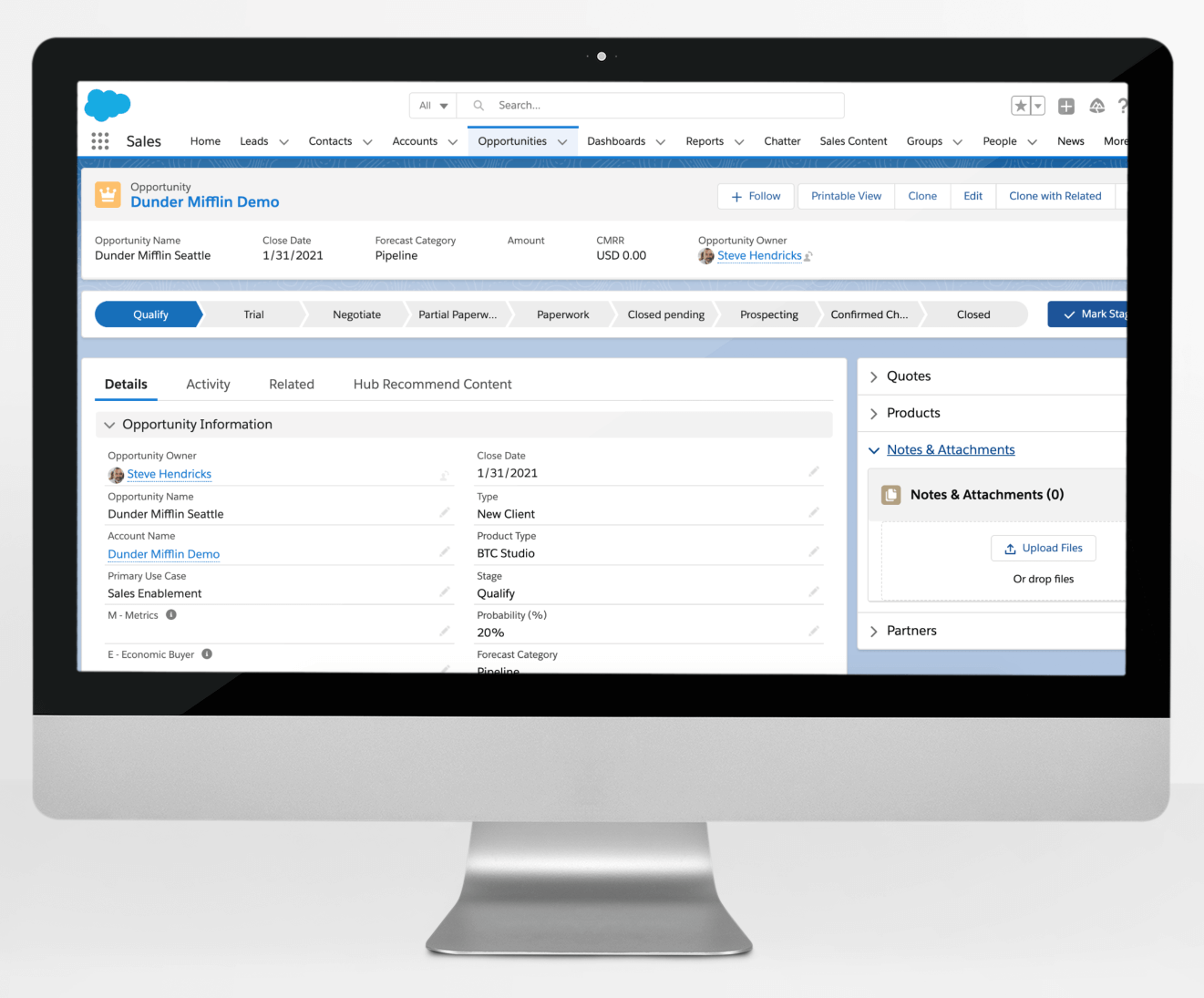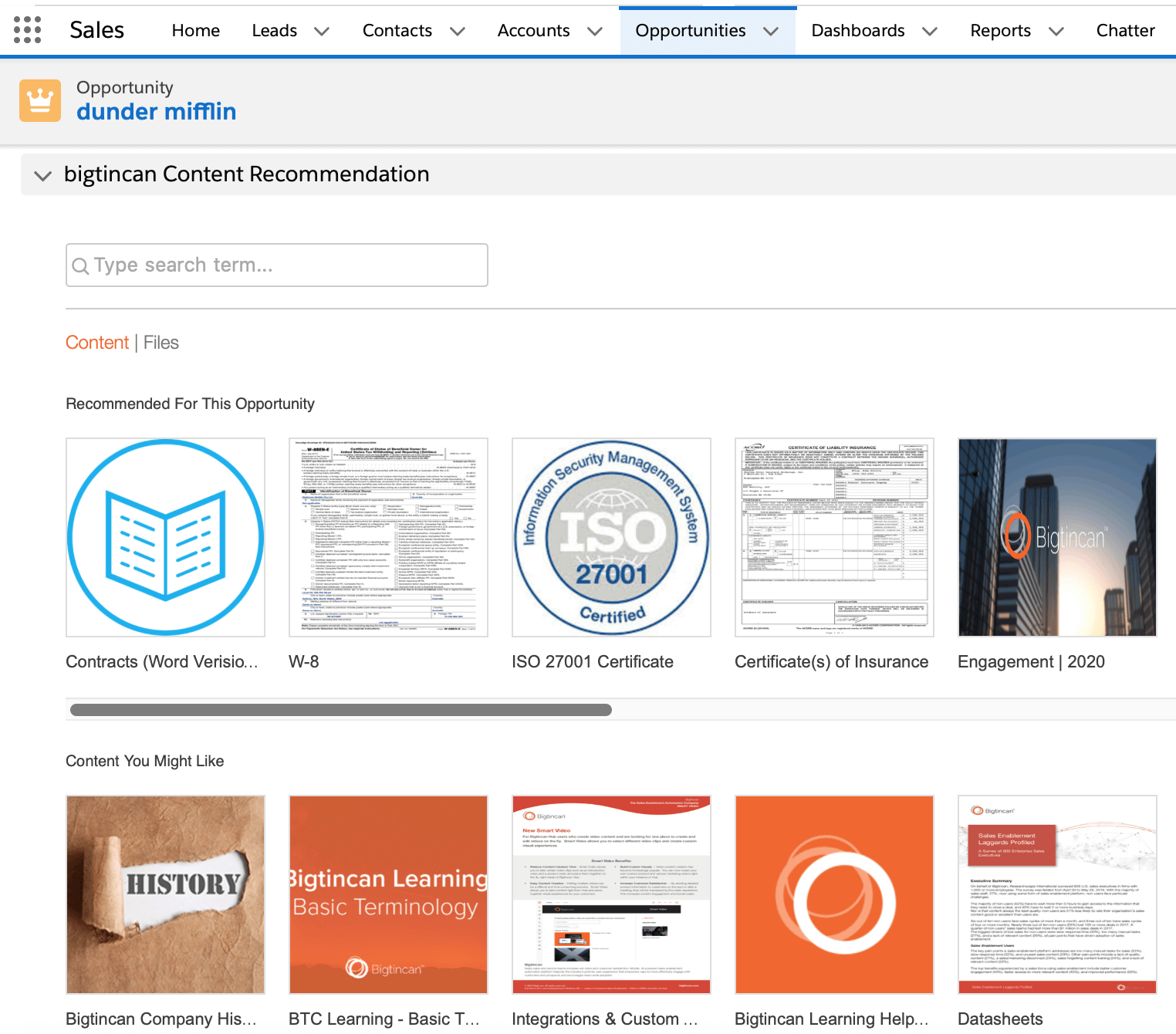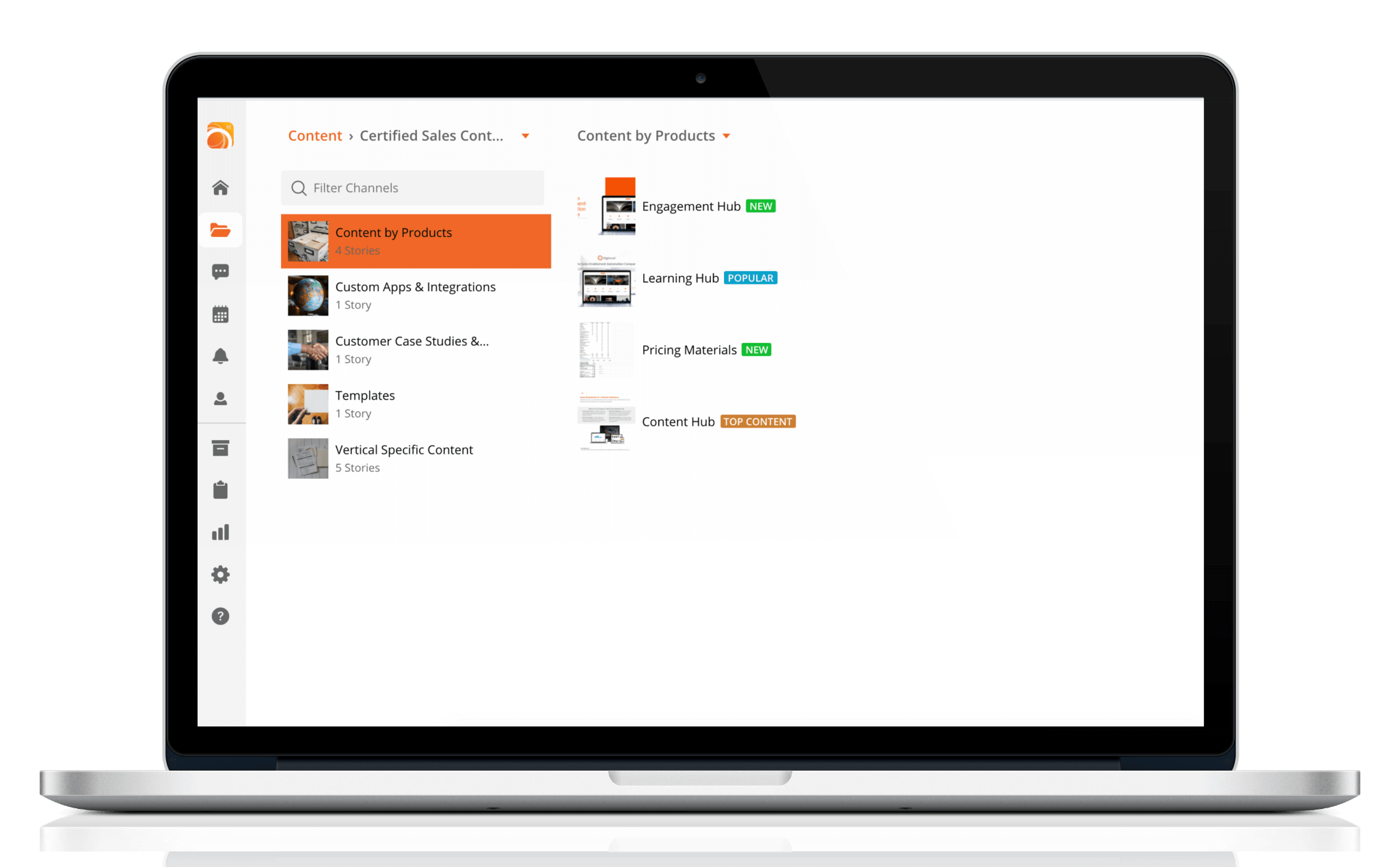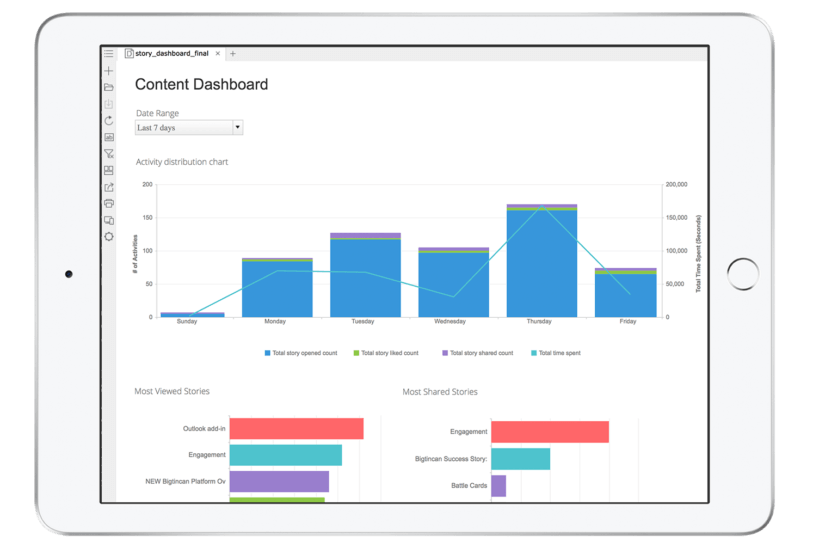When your document management system isn't tightly integrated with Salesforce, your sales team wastes a lot of time and mental energy trying to find and organize the assets they need to service their in-flight deals.
Details fall through the cracks, sellers forget to send a piece of content to a buyer, or they send it and forget to track the activity.
And when another team member steps in to help, it's unclear which assets were used or who sent them, wasting even more of your sellers' time trying to figure out the next steps.
When the CRM and document management systems are closely integrated, it becomes much easier to use documents and track activity more effectively. Now:
- Your sellers can spend more time selling and less time jumping between different tools to grab files or share links.
- Your sales team can easily onboard accounts and determine which documents they've sent to buyers.
- Real-time capture of document usage information through Salesforce API automatically tracks activities and tasks.
- Your team has insight into which assets are used regularly and which ones are performing best.
Since Bigtincan is primarily used as a document management tool for sales teams, we take our integration with CRMs — especially Salesforce — very seriously. Keep reading to learn how it works.
Note: If you’d like to learn more or get your questions answered, the quickest and easiest way to do so is to book a Bigtincan Demo.
How Bigtincan makes document management in Salesforce easy
We designed the Bigtincan’s Salesforce integration to make sure three essential things happened for sellers:
- Sellers always know where to look for files and have access to the documents they need without leaving Salesforce.
- Sellers can easily track their activity by attaching assets they send to a Salesforce object, whether it’s a lead, opportunity, or contact.
- Sellers and sales leaders have a high degree of confidence that every opportunity is up to date and displays an accurate record of all documents that have been used or sent during the process.
Below, we’ll walk through how Salesforce users can do that using Bigtincan.
Find and send assets right from Salesforce (regardless of your cloud storage system)
The number one benefit of the Bigtincan Salesforce app is that it acts as a “single source of truth,” or single interface where you can find all company assets, regardless of where they’re stored, whether you use Google Docs, Box, OneDrive, Dropbox, Sharepoint, or others. Or all of the above.
Bigtincan integrates with all of these (and many more) document management systems, and pulls all the files into one searchable document repository.
Then, that repository can be accessed via the Bigtincan Salesforce App.
In our experience, without Bigtincan, sellers have to hunt through external document folders on each platform to find the files they need, or waste time emailing coworkers to ask for files. Or worse, they use old files they have stored on their desktop that haven’t been updated in months.
After Bigtincan, the sales team always knows where to look: in Bigtincan.
Quickly find files from any repository with AI-powered Search
One of the most important features of Bigtincan is our powerful, AI-enhanced search that finds files across departments and repositories. At the enterprise scale, search is essential because sales reps can’t waste time sifting through hundreds or thousands of folders in different repositories.
Our powerful search and unified repository functionality are carried over into the Bigtincan Salesforce app where sellers can browse and search for files without leaving the CRM.
Here’s how it works.
Just click on the “Bigtincan” documents tab in the opportunity interface:

Once there, you can use Bigtincan’s powerful search feature to find any file you need.

For example, let’s say you need to send the latest “product specification” PDF file to a prospect, but marketing just updated the file this morning and dropped it in Dropbox.
When you search “product specification brochure,” the latest version will automatically show up in the results.
This helps sales and marketing stay on the same page, and helps sellers find the most updated, and on-brand content in seconds, without leaving the CRM platform.
As you find the files you need, you can easily send them to buyers or other external users from the Bigtincan “Current Share” page.

Once sent, these files will automatically be attached to the opportunity for later reference so sellers can keep track of their activities without jumping in and out of the document management system.
Finally, besides using the search feature, sellers can browse recommended sales and learning materials imported from the central Bigtincan system. These features are particularly useful if the seller isn’t 100% sure what to send to the prospect.

Together, these features help sellers use documents to move the sales cycle along without leaving the CRM.
Rather than having to search for a file in multiple document management systems, then download it, and upload/attach it to Salesforce, the seller can perform a quick search, pull in a file from anywhere, and use it right away.
The end result is less time spent finding files and tracking activities, and more time spent interacting with buyers.
How Bigtincan’s standalone document management system works
Whenever sellers need a bit more functionality or screen space to complete a task, they can turn to the full Bigtincan document management platform.
Again, Bigtincan acts as a single repository for all content, regardless of where it’s stored, and provides tools to make the best content easy to find and consume.
Plus, the repository is combined with additional features that help sellers:
- Track sales activities even when they’re not using the CRM.
- Give sellers insights into what content is performing well to move the sale forward.
- Do all of this on any device — even without an internet connection.

The Bigtincan homepage (above) displays dynamic content depending on your settings and what’s new or performing well.
If you’d like to store content or organize it by opportunity or lead, you can do that in the content section.
Simply add a new section (called “Tabs” in Bigtincan) and use it as file storage for that opportunity.
Then, all of your activity in that Tab will be automatically recorded in the Salesforce platform (more on that below).

Plus, Bigtincan is available as a mobile app that works on any mobile device operating system, including iOS and Android.
For the full details on our document management system, check out this article on how to use Bigtincan for sales enablement.
For now, here are a few especially important features for sellers:
Automatically track all activity in the CRM
Any activity within the Bigtincan app will automatically sync to Salesforce so sellers don’t have to worry about manually logging every detail, but sales teams and leaders still reap the rewards of consistent communication and tracking.
For example, if you’re working in Bigtincan and send a file to a client, that action will automatically be tracked in Salesforce and added to the relevant opportunity, lead, or other Salesforce record.
Or, if you book a meeting or present to a buyer using Bigtincan’s optional calendar and presentation tools, those activities will be tracked as well.
All of this functionality works on or offline, so if you present within Bigtincan in a conference room with no WiFi, Bigtincan will store that information locally and upload it to Salesforce as soon as internet becomes available.
With these tools, less information and activity falls through the cracks, and CRM usage becomes easier for sellers, regardless of where or how they work.
Personalized search results help sales teams find exactly what they need
The search feature in Bigtincan is backed by artificial intelligence (AI), which is designed to help you surface the files you need more quickly. The AI engine automatically considers the searcher’s role, industry, recent activity, experience level, and more.
For example, if a seller at a life sciences company were to search “Product benefits brochure,” Bigtincan would pull information from Salesforce and an HR platform and take into account that:
- The searcher works in the surgical visualization niche.
- The searcher is in the USA.
- “Brochure” typically means PDF.
- The full text of a specific PDF includes the keywords “product benefits”.
- That PDF was recently updated by marketing.
Bigtincan would then deliver the most updated version of the relevant file.
All of this happens without extensive file-tagging, works across repositories, and even when you’re offline.
Work offline and on all devices
Bigtincan was built around the idea that sellers are often on the move — working in coffee shops, hotels, and lobbies — and often don’t have a great WiFi connection. Their tools should be able to adapt to these conditions.
For that reason, Bigtincan was built to work on any device, and offers nearly identical functionality offline as online.
Specifically, this means that fully functioning search is available offline (including AI features), and usage statistics are stored offline and uploaded to the cloud when internet access is available.
Learn more about our mobile and offline sales enablement features here.
Customize the interface to suit your workflow
Out of the box, Bigtincan’s content management interface is designed to be easy to use, so anyone can manage files quickly, without sorting through endless file folders.
However, you can also custom-tailor the interface itself to suit your workflow and brand. This is especially important if you want your DMS to be partner or customer-facing — for example, if you’d like to present a specific document to a customer or switch to another file without leaving the content management system.
See how buyers interact with documents using sales analytics
Whenever you send a document — from Salesforce or otherwise — Bigtincan helps you track usage statistics for each document so you can see what content is working.
For every document you can see:
- Who viewed a document.
- How long they spent looking at the document.
- Which specific pages or slides they viewed.
- How long they spent in each section.
- And more.

 Further reading: From insight to action: Buyer engagement insights sales directors can use to improve sales processes
Further reading: From insight to action: Buyer engagement insights sales directors can use to improve sales processes
With these page-level insights, sellers can adjust their approach and adapt to buyer behavior more easily.
For example, if they notice a stakeholder has spent a lot of time on the pricing page, they can brush up on pricing points and objections before the next call. Or, if a prospect is focused on technical specs, the seller could coordinate with a sales engineer in advance to answer any questions.
With this information, sellers can stay one step ahead, the buyer will have a smoother customer experience and get their questions answered more quickly, and the sale can move forward at a faster rate.
